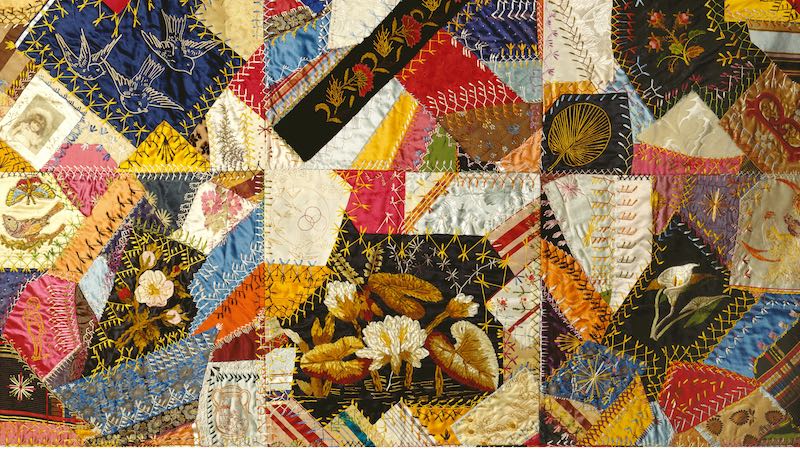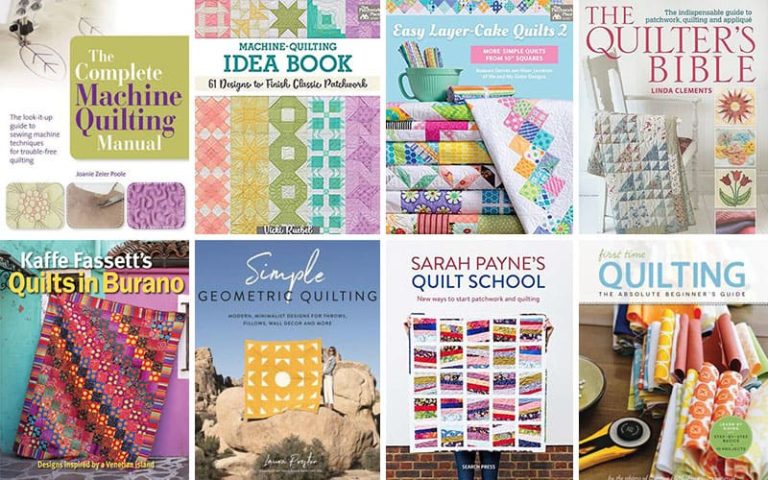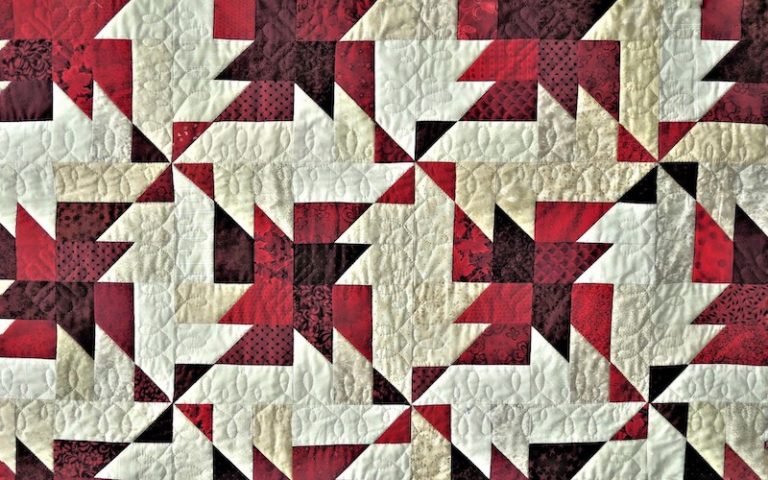Quilting is a craft enjoyed by millions of people today. The roots of this tradition stretch all the way back to ancient times.
Let’s take a look at the history of quilting and how quilting styles and techniques have evolved over time.
What is quilting?
Quilting is a particular sewing technique. Although often associated with patchwork, quilting simply means stitching different layers of fabric together.
Typically, this involves two layers of fabric with a layer of padding in between. All layers are stitched together with many lines of stitching that themselves form a pattern. In quilting terms, this padding is called batting or wadding.

Quilting can use a variety of stitches, though basic running stitch is the most common. Although the stitch itself is simple, sewing it is complicated, because it must pass neatly through all layers of the quilt, including the bulky padding.
Additionally, quilting often involves lines of decorative stitches. These lines can be made to form intricate patterns that are decorative in and of themselves and add an extra dimension to the project.
These days, quilting can be done either by hand or on a sewing machine. Some modern sewing machines are designed with quilters in mind and feature functions and accessories for flawless quilting.
Modern quilting integrates the traditional techniques developed over centuries, as well as incorporating new elements. Contemporary quilting projects can be anything from traditional quilts almost identical to those made by our great grandmothers, to innovate wall hangings with ultra-modern prints and motifs.

Source: Wikimedia / OttawaAC
Although most commonly used to create bedding, quilting has long been used to decorate many different objects, from garments to home décor items. Although often used to make practical items, quilted projects can also be purely decorative, such as wall hangings.
Quilts often have enormous sentimental value and many have been passed down in families for generations. They may be created to commemorate special life events, such as the birth of a child, or to mark other important events.
How was quilting invented?
Historians cannot be sure when exactly quilting was invented, but they do know that the history of quilting goes back at least to medieval times.
It is possible that quilting was used in ancient times: an ancient Egyptian ivory carving shows a king wearing what appears to be a quilted cloak. There is also evidence of quilting in Asia dating back around 2000 years.
The first recorded use of the word “quilt” was in 13th-century England, and probably came for the Latin word “culcita” meaning a bolster or cushion.

Source: Wikimedia / Mabalu
The earliest use of quilting was to make bed covers, just as we continue to make quilts to keep or beds warm today. We know this because quilts are frequently mentioned in the recorded inventories of medieval households. Many of these quilts became family heirlooms and were passed down through generations.
Quilting was also used to make clothing in medieval times. It was a preferred method of making garments because quilting clothes were light and warm.
Quilting in Europe
In Europe, quilted clothing was worn underneath armor to add a layer of padding for extra comfort. For soldiers who couldn’t afford armor, quilted outerwear was used to provide some protection.
There are also examples of early quilted garments from Asia that were worn by local nobles as well as exported to the West.

Source: Wikimedia / Los Angeles County Museum of Art
Quilting became extremely popular in the UK in the 17th century. The professional quilting industry thrived in major cities and made large quilts, as well as quilted garments for the nobility.
Intricate quilts were also imported from India to Britain and Europe. These beautiful quilts were often made of chintz, a cotton fabric that is hand-painted and dyed.
Communal quilting
Although quilts were professionally-made, there is also a long tradition of domestic quilting across Europe and North America. People made quilts and quilted garments to keep warm, as well as to mark special occasions or for a dowry.
The huge and intricate nature of quilting projects meant that these were often a communal effort. Social quilt-making became popular, with groups of quilters sitting around a large quilt, working on different sections at the same time.
Communal quilting became an important part of the culture in places like North America, particularly in the communities established by Dutch settlers. Traditions such as holding a quilt-making bee for someone before they get married developed in the 19th century and are still observed today.

Source: Wikimedia / Suzanne Szasz
In the 20th century quilting and in particular patchwork techniques were used by the mainstream fashion industry. Notably, the hippie trends of the 1960’s made heavy use of patchwork designs.
In the last part of the 20th century and the beginning of the 21st, quilting has become more popular than ever as a hobby and an art form.
Trapunto quilting developed in Italy in the 13th century. This quilting technique gets its name from the Italian “trapunture” meaning “to quilt”, and is also known as stuffed quilting.
Trapunto quilting uses stuffing to create raised areas in the quilt, generating a three-dimensional effect. This technique is still used in quilting today to create intricate and visually stunning projects.
Patchwork quilting
Patchwork developed as a popular way to make quilts. Related to but distinct from quilting, patchwork is a needlework technique that involves sewing pieces of fabric together to form what is essentially a new textile.
Patchwork was particularly popular with domestic quilters because it enabled them to use up scraps of fabric and so create quilts and garments while saving money. As patchwork spread, it started to be adopted by the wealthy, who would buy expensive fabric to create beautiful patchwork quilts.

Source: Wikimedia / angela n.
The technique of paper piecing, or “piecing over paper” developed in Britain in the 1770’s. In this method, the pattern is drawn and cut out on paper, before folding the fabric around the pieces of paper and joining the fabric pieces together.
This quickly became the most popular way to create patchwork designs in the region, and is so closely associated with Britain that it is still known as “English paper piecing” today.
Other quilting styles
Decorative stitching became an important component of quilting in the early 19th century. At this time, whole-cloth quilting, also known as counterpane, became popular and these quilts showcased intricate stitching and cording.
As they spread and became more common, stitching patterns were given names such as “Broken Plaid”, “Hanging Diamond”, “Twisted Rope” and “True Lovers’ Knot”.
Around this time, applique techniques also emerged, with smaller pieces of contrasting fabrics cut into shapes and stitched on the surface of the quilt. These stunning decorations relied on expensive fabrics and intricate needlework, so were the reserve of the wealthy.

Source: Wikimedia / Serge Melki
The Amish settlers in Pennsylvania and the Midwest adapted their bedding to suit the warmer conditions of their new home. This included summer quilts made without the heavy padding in the middle, and the hand-tying method of making quilts.
The invention of the sewing machine in the mid-19th century meant that quilters could work much faster than by hand. This prompted the development of more decorative and ornate quilts that also used the new fabrics and prints of the 19th and 20th centuries.
What is the oldest quilt pattern?
There a number of traditional quilt patterns that have been used for centuries and passed down through generations of quilters. Traditional quilt patterns used by American pioneers included the nine patch, log cabin, pinwheel, eight-pointed star, and friendship quilt.
The oldest quilt pattern was probably what we now call the “crazy quilt”. This pattern does not have a structured design, but instead pieces together scraps of fabric as they come, fitting the shapes together regardless of color, print, or texture.
Most early quilters did not have the luxury of buying fat quarters or even yards of fabric. Instead, they used scraps of fabric left over from other projects, as well as repurposing worn out clothing or household linens.
Although this results in a random and somewhat chaotic result, every piece has its own history and tells a story.

Source: Wikimedia
The oldest known quilted object was found in a Siberian cave tomb. It is a quilted linen carpet that has been dated to the first century C.E., making it around 2000 years old.
The carpet features animal and spiral motifs worked in backstitch, with a diamond-quilted background made with running stitch.
We don’t know whether the Siberians invented these techniques or picked them up from traders from Asia or the Middle East. Other early quilted artefacts found along the Silk Road (the trading route from China to Europe), suggest that quilted objects were indeed traded between the continents.
Final thoughts
Over time, the popularity of quilted objects saw the development of new styles and techniques, born not only out of practicality but also art and beauty. Quilts became stunning works of art, incorporating techniques from patchwork and applique to trapunto, many of which are still used by quilters today.
Why not try out quilting yourself? Check out this post on quilting styles and techniques, or this list of easy quilt patterns for beginners.









